Three-Dimensional Audio-Magnetotelluric Imaging including Surface Topography of the Cimabanshuo Porphyry Copper Deposit, Tibet
Abstract
:1. Introduction
2. Geological Settings of the Cimabanshuo Porphyry Copper Deposit
3. AMT Data Acquisition and Processing
4. The Dimensionality and Strike Direction Analysis of AMT Data
5. Three-Dimensional Inversion with Topography of AMT Data
6. Geological Interpretations of the Electrical Resistivity Models
6.1. High-Resistivity Potassic Intrusive Rocks
6.2. High-Conductivity or Sulfide-Rich Foliate Alteration Zone
6.2.1. Argillic Alteration Zone
6.2.2. Massive Sulfide
6.2.3. Foliate Alteration Zone
7. Conclusions
- (1)
- A large range of high-resistivity anomaly (~500–2000 Ωm) appears beneath the proven Cu mineralization zone and ore bodies, and is interpreted as intrusive rock with potassic alterations. Although containing chalcopyrite, it is characterized by middle–high resistivity due to low sulfide content and poor connectivity.
- (2)
- A series of scattered conductors (~10–300 Ωm) around the Cu ore bodies are distributed in the shallow layer from near-surface area to ~200 m, possibly indicating a phyllic alteration containing pyritization and connected metal sulfides.
- (3)
- The proven ore bodies of Cimabanshuo are mainly located at the junction regions of high-resistivity intrusive rocks and relatively high-conductivity sericitization alteration zones.
Supplementary Materials
Author Contributions
Funding
Data Availability Statement
Acknowledgments
Conflicts of Interest
References
- Kesler, S.E.; Wilkinson, B.H. Earth’s copper resources estimated from tectonic diffusion of porphyry copper deposits. Geology 2008, 36, 255–258. [Google Scholar] [CrossRef]
- Richards, J.P. Postsubduction porphyry Cu-Au and epithermal Au deposits: Products of remelting of subduction-modified lithosphere. Geology 2009, 37, 247–250. [Google Scholar] [CrossRef]
- Sillitoe, R.H. A Plate Tectonic Model for the Origin of Porphyry Copper Deposits. Econ. Geol. 1972, 67, 184–197. [Google Scholar] [CrossRef]
- Richards, J.P. Tectono-Magmatic Precursors for Porphyry Cu-(Mo-Au) Deposit Formation. Econ. Geol. 2003, 98, 1515–1533. [Google Scholar] [CrossRef]
- Sillitoe, R.H.; McKee, E.H. Age of supergene oxidation and enrichment in the Chilean porphyry copper province. Econ. Geol. 1996, 91, 164–179. [Google Scholar] [CrossRef]
- Mathur, R.; Ruiz, J.; Munizaga, F. Relationship between copper tonnage of Chilean base-metal porphyry deposits and Os isotope ratios. Geology 2000, 28, 555–558. [Google Scholar] [CrossRef]
- Hou, Z.Q.; Meng, X.J.; Qu, X.M.; Gao, Y.F. Copperore potential of adakitic intrusives in Gangdese porphyry copper belt: Constrains from rock phase and deep melting process. Miner. Depos. 2005, 24, 121–132. [Google Scholar]
- Lowder, G.G.; Dow, J.A.S. Geology and exploration of porphyry copper deposits in North Sulawesi, Indonesia. Econ. Geol. 1978, 73, 628–644. [Google Scholar] [CrossRef]
- Pinet, N.; Gloaguen, E.; Giroux, B. Introduction to the special issue on geophysics applied to mineral exploration. Can. J. Earth Sci. 2019, 56, 5–8. [Google Scholar] [CrossRef]
- Lowell, J.D.; Guilbert, J.M. Lateral and vertical alteration-mineralization zoning in porphyry ore deposits. Econ. Geol. 1970, 65, 373–408. [Google Scholar] [CrossRef]
- Mitchinson, D.E.; Enkin, R.J.; Hart CJ, R. Linking Porphyry Deposit Geology to Geophysics via Physical Properties: Adding Value to Geoscience BC Geophysical Data; Geoscience BC: Vancouver, BC, Canada, 2013. [Google Scholar]
- Hübert, J.; Lee, B.M.; Liu, L.; Unsworth, M.J.; Richards, J.P.; Abbassi, B.; Cheng, L.Z.; Oldenburg, D.W.; Legault, J.M.; Rebagliati, M. Three-dimensional imaging of a Ag-Au-rich epithermal system in British Columbia, Canada, using airborne z-axis tipper electromagnetic and ground-based magnetotelluric data. Geophysics 2015, 81, B1–B12. [Google Scholar] [CrossRef] [Green Version]
- Nelson, P.H. Estimation of sulfide content from induced polarization data. Geophysics 1983, 48, 62. [Google Scholar] [CrossRef]
- Meju, M. Geoelectromagnetic Exploration for Natural Resources: Models, Case Studies and Challenges. Surv. Geophys. 2002, 23, 133–206. [Google Scholar] [CrossRef]
- Lee, B.M.; Unsworth, M.J.; Hübert, J.; Richards, J.P.; Legault, J.M. 3D joint inversion of magnetotelluric and airborne tipper data: A case study from the Morrison porphyry Cu–Au–Mo deposit, British Columbia, Canada. Geophys. Prospect. 2018, 66, 397–421. [Google Scholar] [CrossRef]
- Strangway, D.W.; Swift, C.M.; Holmer, R.C. The application of audio-frequency magnetotellurics (AMT) to mineral exploration. Geophysics 1973, 38, 1159–1175. [Google Scholar] [CrossRef]
- Sandberg, S.K. Controlled-source audiomagnetotellurics in geothermal exploration. Geophysics 1982, 47, 100. [Google Scholar] [CrossRef]
- Johannes, S.K.; Alexander, V.G.; Alexey, V.K. Topographic distortions of magnetotelluric transfer functions: A high-resolution 3-D modelling study using real elevation data. Geophys. J. Int. 2018, 215, 1943–1961. [Google Scholar]
- Dong, H.; Wei, W.B.; Ye, G.F.; Jin, S.; Jing, J.E. Study of Three-dimensional magnetotelluric inversion including surface topography based on Finite-difference method. Chin. J. Geophys. 2014, 57, 939–952. [Google Scholar]
- Li, S.H.; Booker, J.R.; Aprea, C. Inversion of magnetotelluric data in the presence of strong bathymetry/topography. Geophys. Prospect. 2008, 56, 259–268. [Google Scholar] [CrossRef]
- Wang, R.; Richards, J.P.; Zhou, L.M.; Hou, Z.Q.; Stern, R.A.; Creaser, R.A.; Zhu, J.J. The role of Indian and Tibetan lithosphere in spatial distribution of Cenozoic magmatism and porphyry Cu–Mo deposits in the Gangdese belt, southern Tibet. Earth Sci. Rev. 2015, 150, 68–94. [Google Scholar] [CrossRef]
- Hou, Z.Q.; Zhang, H.R. Geodynamics and metallogeny of the eastern Tethyan metallogenic domain. Ore Geol. Rev. 2015, 70, 346–384. [Google Scholar] [CrossRef]
- Zhao, Y.Y.; Liu, X.F.; Liu, Y.C.; Liu, B.; Fu, H.L.; Lv, J.L.; Zheng, C.Y. Copper metallogenic condition of Cimabanshuo area around Zhunuo copper mine in Tibet. Gansu Geol. 2017, 26, 28–36. [Google Scholar]
- Sun, X.; Hollings, P.; Lu, Y.-J. Geology and origin of the Zhunuo porphyry copper deposit, Gangdese belt, southern Tibet. Miner. Depos. 2021, 56, 457–480. [Google Scholar] [CrossRef]
- Zhao, Y.Y.; Liu, X.F.; Liu, Y.C.; Ci, Q.; Xiao, L.B.; Li, L.; Zhang, X.Q. Zircon U-Pb Ages and Geochemical Characteristics of Youqiumi Porphyry Pluton in Cimabanshuo Area, Tibet. Earth Sci. 2018, 43, 4551–4565. [Google Scholar]
- Huang, H.X.; Liu, H.; Li, G.M.; Zhang, L.K.; Cao, H.; Zhou, Q.; Wang, X.X.; Yan, G.Q. Zircon U-Pb, Molybdenite Re-Os and Quartz Vein Rb-Sr Geochronology of the Luobuzhen Au-Ag and Hongshan Cu Deposits, Tibet, China: Implications for the Oligocene-Miocene Porphyry–Epithermal Metallogenic System. Minerals 2019, 9, 476. [Google Scholar] [CrossRef] [Green Version]
- Egbert, G.D.; Booker, J.R. Robust estimation of geomagnetic transfer functions. Geophys. J. R. Astron. Soc. 1986, 87, 173–194. [Google Scholar] [CrossRef] [Green Version]
- Egbert, G.D. Robust multiple-station magnetotelluric data processing. Geophys. J. Int. 1997, 130, 475–496. [Google Scholar]
- Chave, A.D.; Jones, A.G.; Mackie, R.; Rodi, W. The Magnetotelluric Method: Theory and Practice; Cambridge University Press: Cambridge, UK, 2012. [Google Scholar]
- Groom, R.W.; Bailey, R.C. Decomposition of magnetotelluric impedance tensors in the presence of local three-dimensional galvanic distortion. J. Geophys. Res. Solid Earth 1989, 94, 1913–1925. [Google Scholar] [CrossRef] [Green Version]
- Caldwell, T.G.; Bibby, H.M.; Brown, C. The magnetotelluric phase tensor. Geophys. J. Int. 2004, 158, 457–469. [Google Scholar] [CrossRef] [Green Version]
- Egbert, G.; Kelbert, A. Computational recipes for electromagnetic inverse problems. Geophys. J. Int. 2012, 189, 251–267. [Google Scholar] [CrossRef] [Green Version]
- Kelbert, A.; Meqbel, N.; Egbert, G.D.; Tandon, K. ModEM: A modular system for inversion of electromagnetic geophysical data. Comput. Geosci. 2014, 66, 40–53. [Google Scholar] [CrossRef]
- Kruschwitz, S.; Yaramanci, U. Detection and characterization of the disturbed rock zone in claystone with the complex resistivity method. J. Appl. Geophys. 2005, 57, 63–79. [Google Scholar] [CrossRef]
- Leng, C.-B.; Cooke, D.R.; Hou, Z.-Q.; Evans, N.J.; Zhang, X.-C.; Chen, W.T.; Danišík, M.; McInnes, B.I.A.; Yang, J.-H. Quantifying Exhumation at the Giant Pulang Porphyry Cu-Au Deposit Using U-Pb-He Dating. Econ. Geol. 2018, 113, 1077–1092. [Google Scholar]
- Zheng, Y.; Sun, X.; Gao, S.; Wang, C.; Zhao, Z.; Wu, S.; Li, J.; Wu, X. Analysis of stream sediment data for exploring the Zhunuo porphyry Cu deposit, southern Tibet. J. Geochem. Explor. 2014, 143, 19–30. [Google Scholar] [CrossRef]
- Wan, X.-Q.; Sun, X. Apatite fission track thermochronology of Cenozoic igneous rocks from porphyry copper deposits in the Gangdese belt of southern Tibet: Implications for cooling history and ore preservation. Ore Geol. Rev. 2021, 133, 104075. [Google Scholar] [CrossRef]
- Palacky, G.J. Geophysical methods in geology. Earth-Sci. Rev. 1988, 25, 87–89. [Google Scholar] [CrossRef]


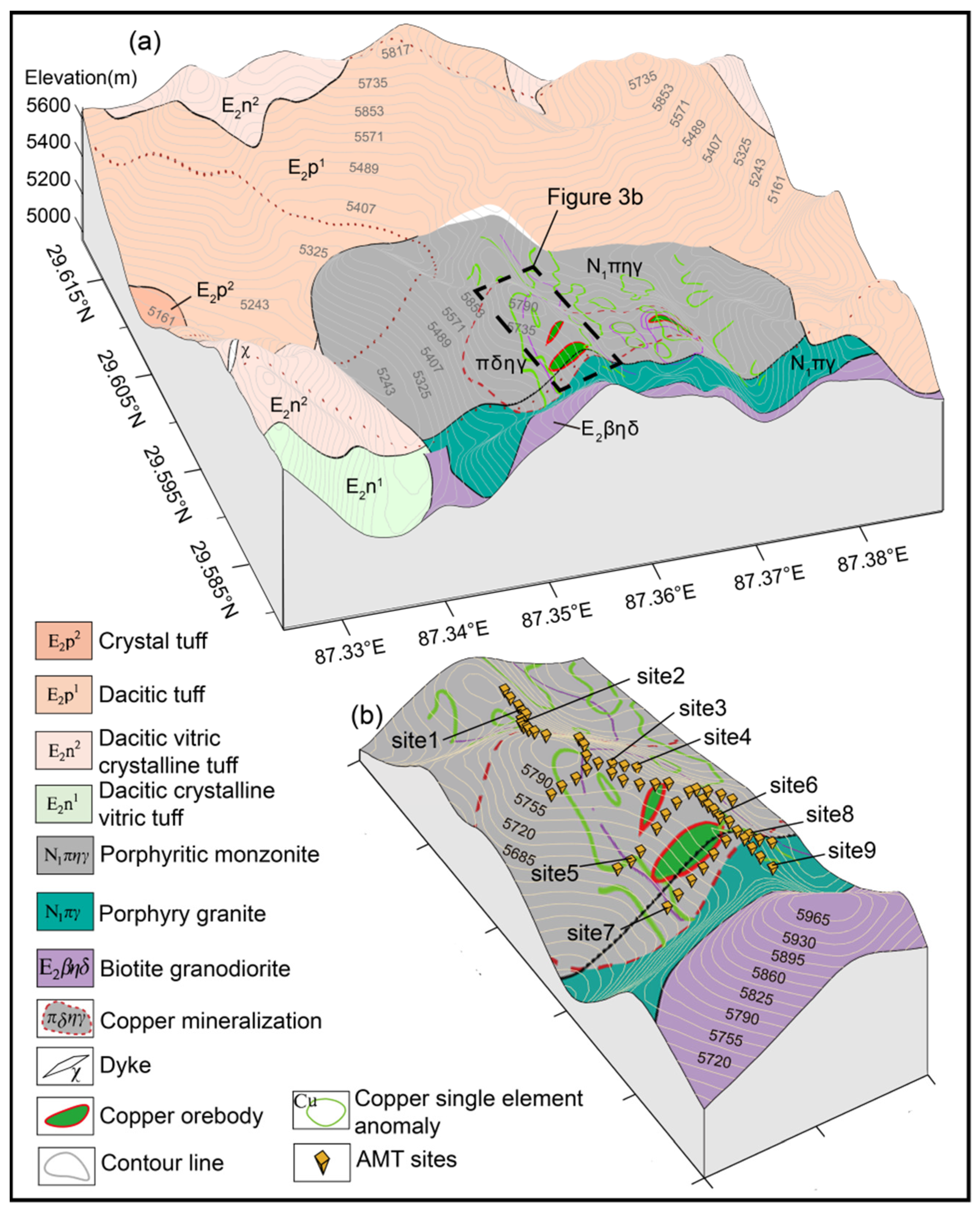

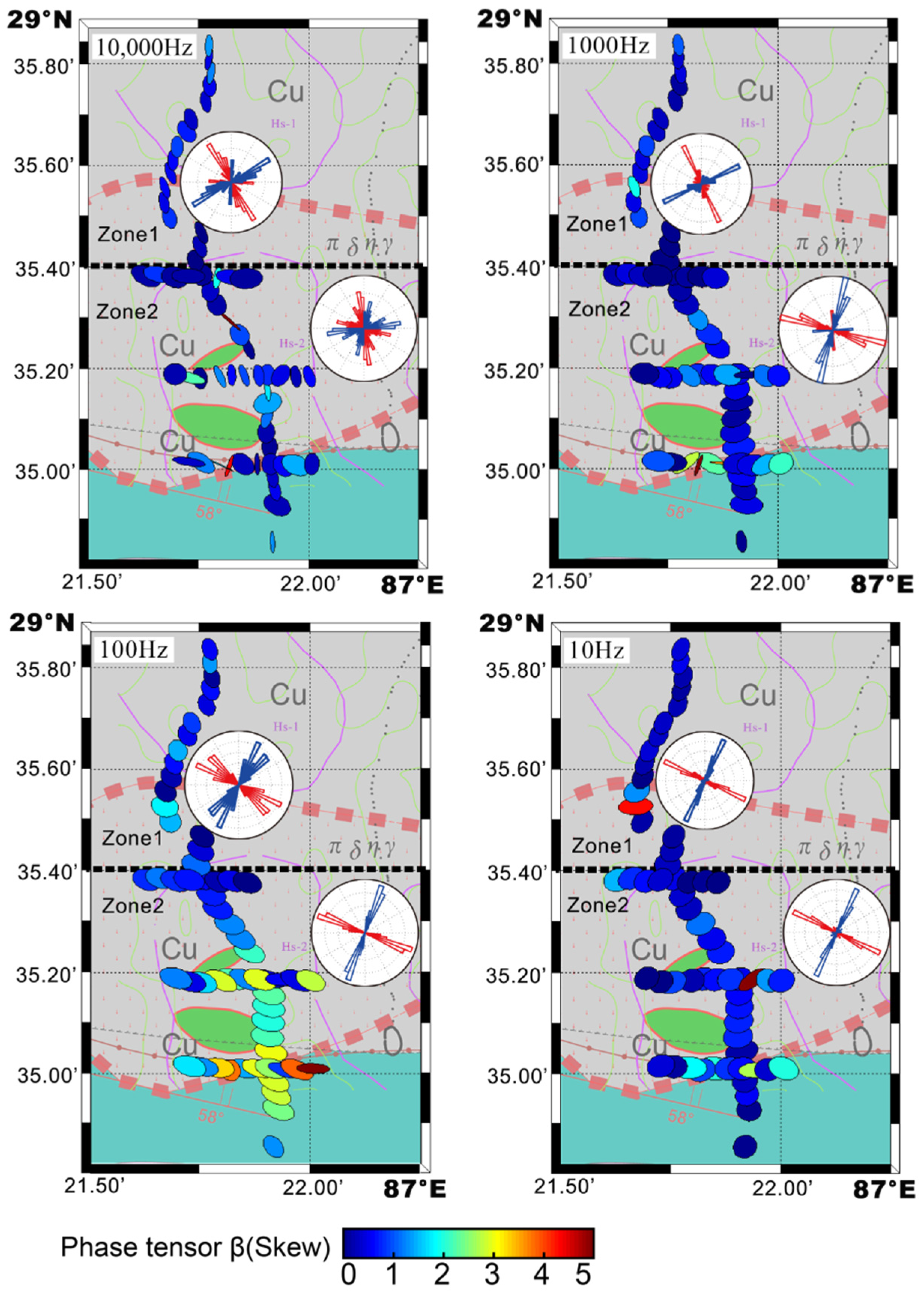
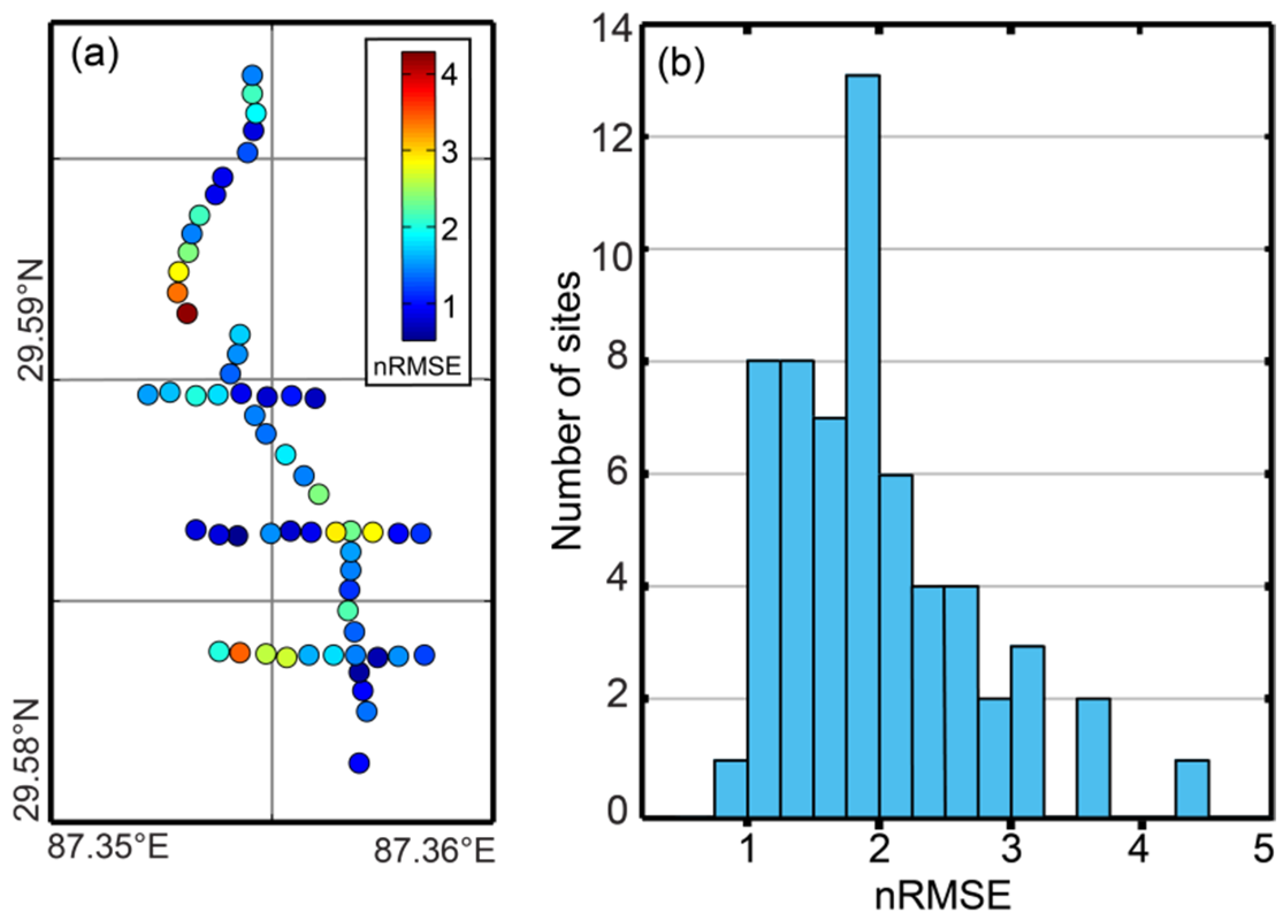
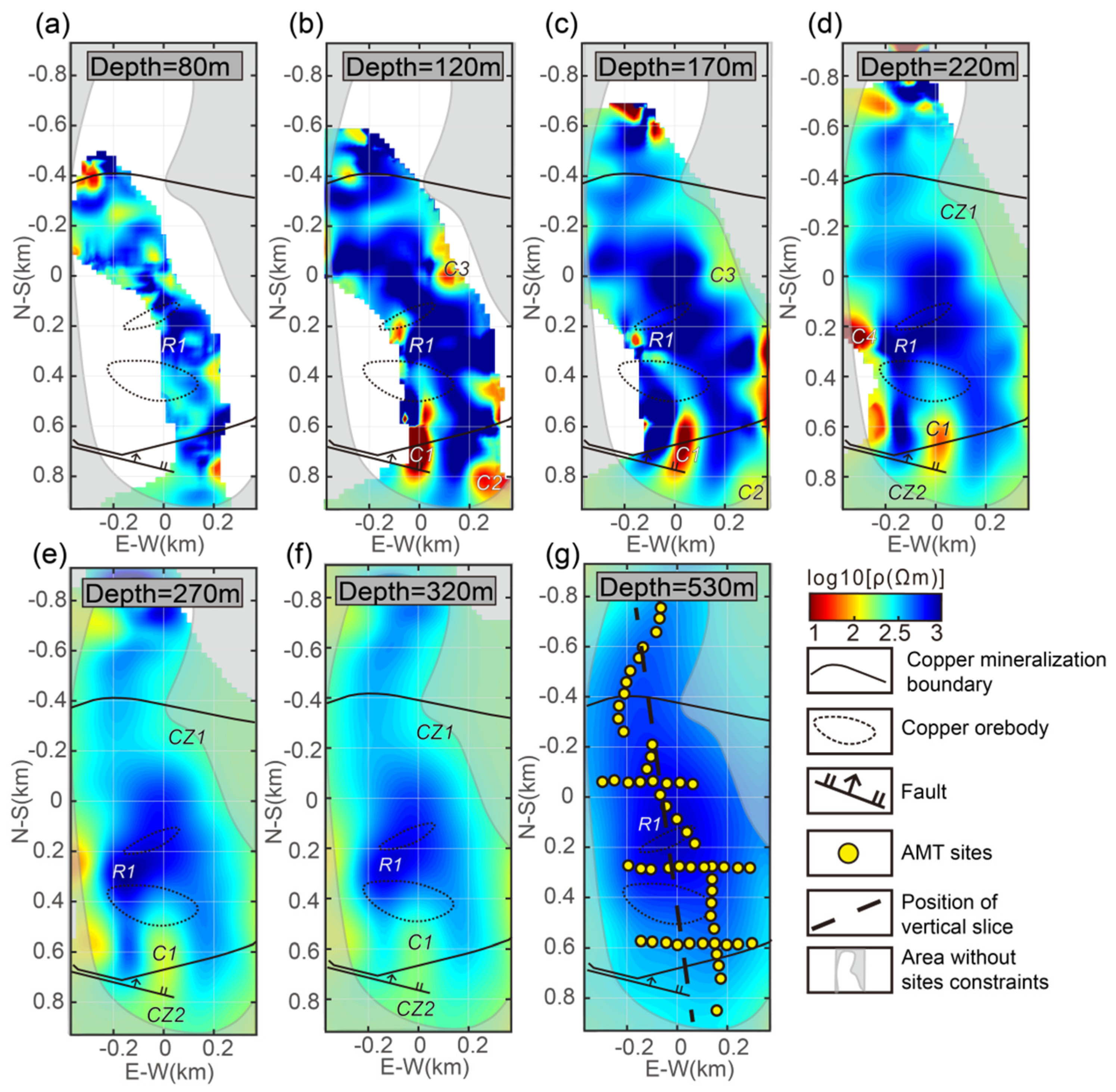
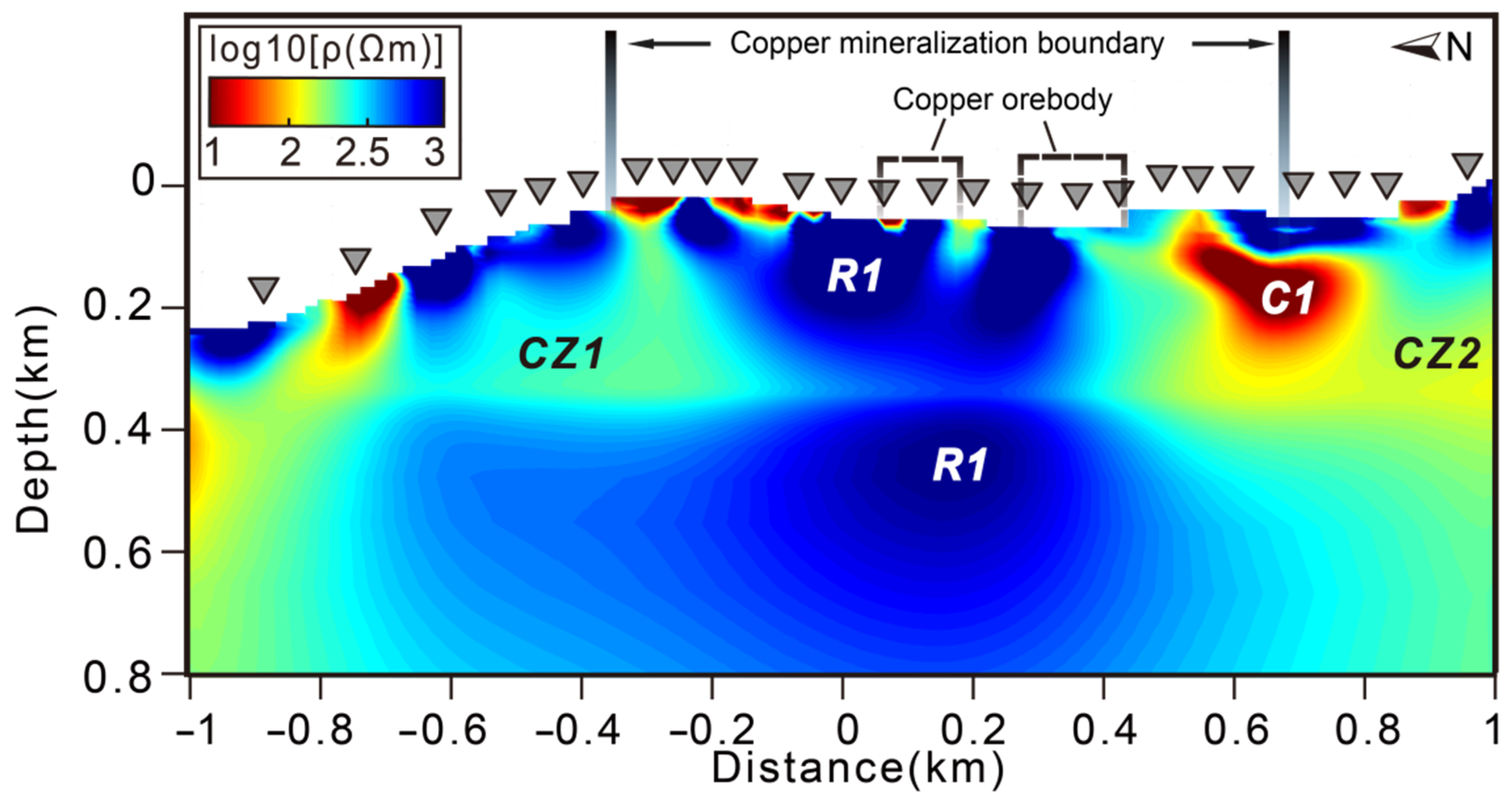
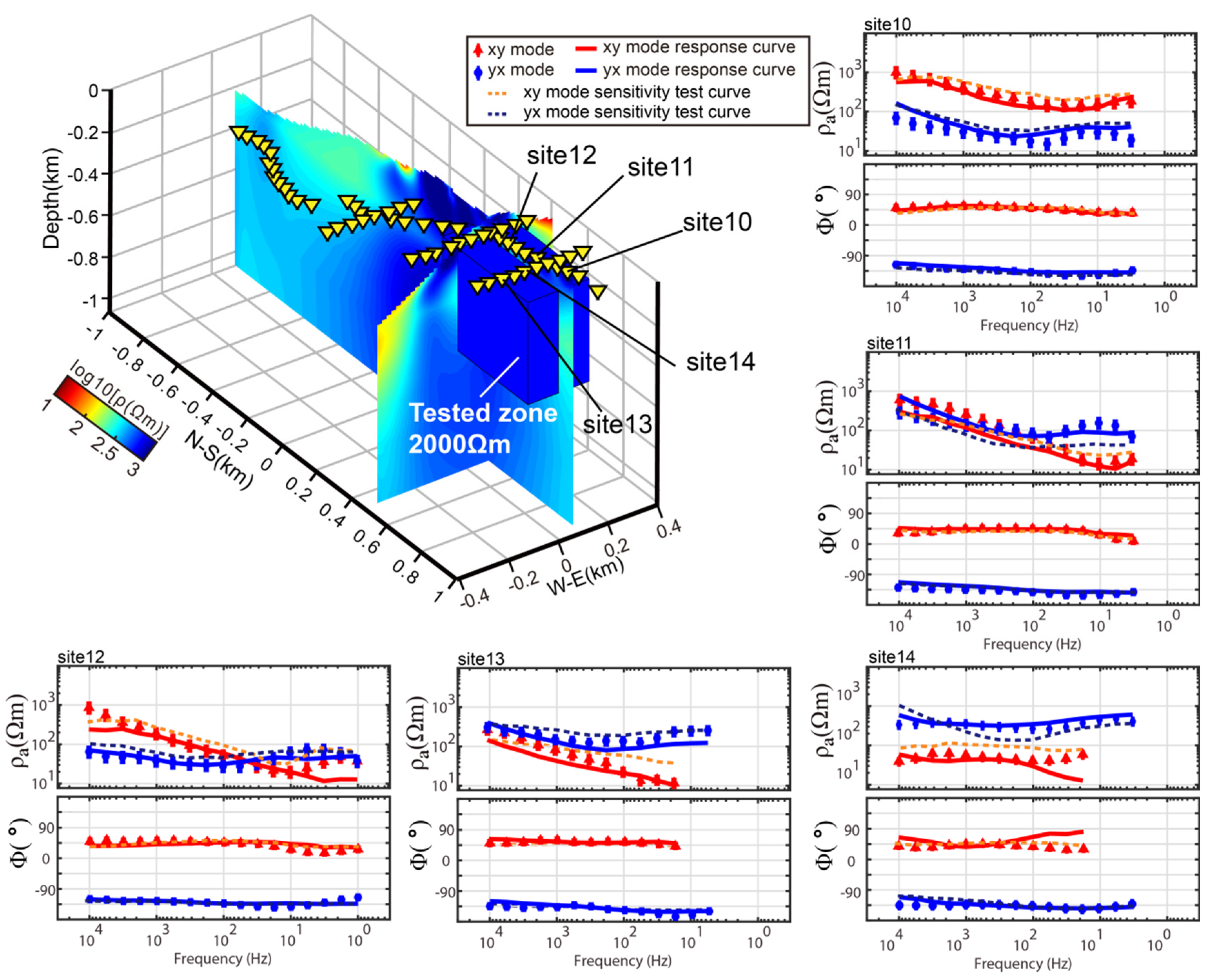
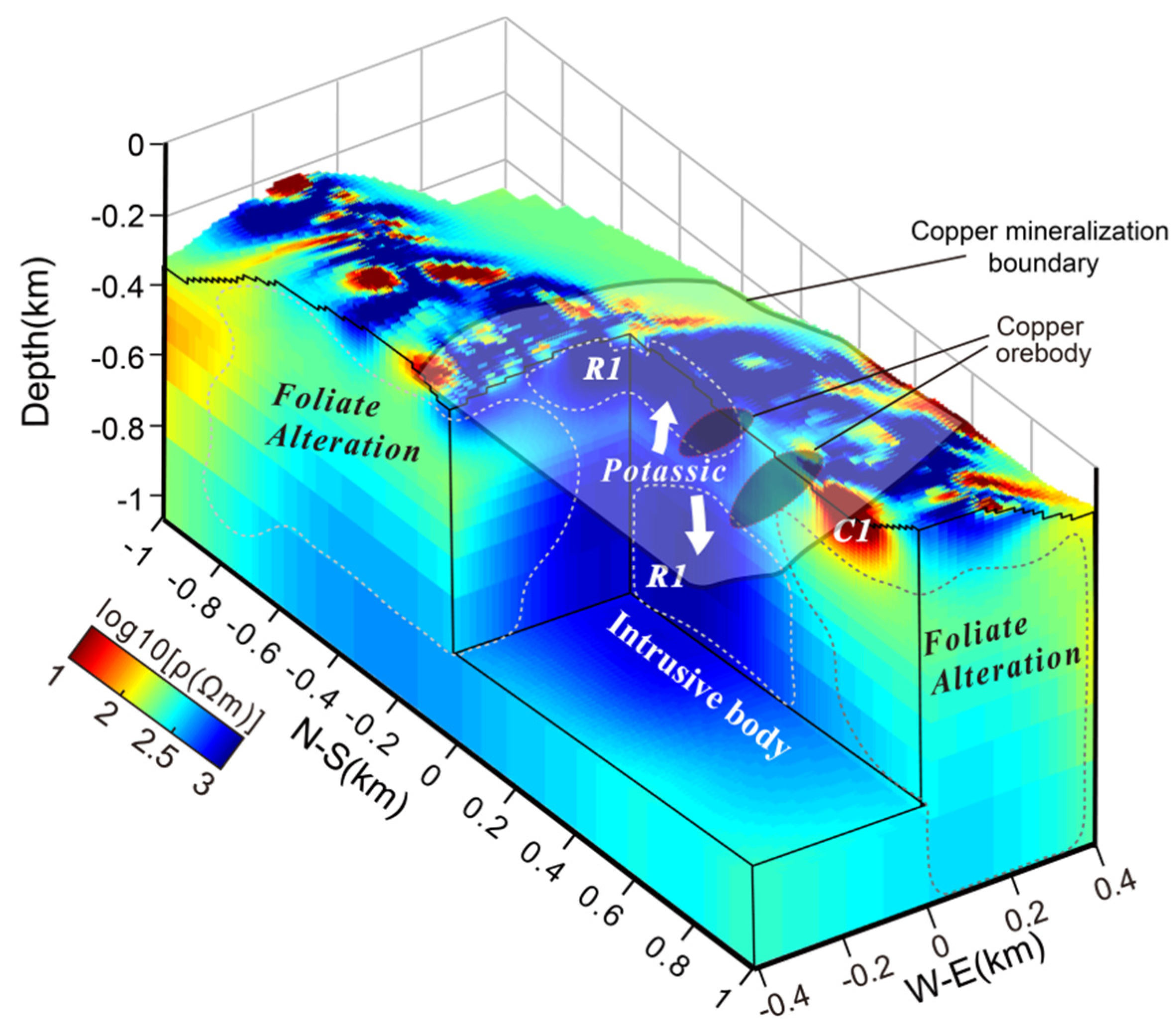
Publisher’s Note: MDPI stays neutral with regard to jurisdictional claims in published maps and institutional affiliations. |
© 2021 by the authors. Licensee MDPI, Basel, Switzerland. This article is an open access article distributed under the terms and conditions of the Creative Commons Attribution (CC BY) license (https://creativecommons.org/licenses/by/4.0/).
Share and Cite
Qi, P.; Yin, Y.; Jin, S.; Wei, W.; Xu, L.; Dong, H.; Huang, J. Three-Dimensional Audio-Magnetotelluric Imaging including Surface Topography of the Cimabanshuo Porphyry Copper Deposit, Tibet. Minerals 2021, 11, 1424. https://doi.org/10.3390/min11121424
Qi P, Yin Y, Jin S, Wei W, Xu L, Dong H, Huang J. Three-Dimensional Audio-Magnetotelluric Imaging including Surface Topography of the Cimabanshuo Porphyry Copper Deposit, Tibet. Minerals. 2021; 11(12):1424. https://doi.org/10.3390/min11121424
Chicago/Turabian StyleQi, Ping, Yaotian Yin, Sheng Jin, Wenbo Wei, Liuyang Xu, Hao Dong, and Jinhui Huang. 2021. "Three-Dimensional Audio-Magnetotelluric Imaging including Surface Topography of the Cimabanshuo Porphyry Copper Deposit, Tibet" Minerals 11, no. 12: 1424. https://doi.org/10.3390/min11121424
APA StyleQi, P., Yin, Y., Jin, S., Wei, W., Xu, L., Dong, H., & Huang, J. (2021). Three-Dimensional Audio-Magnetotelluric Imaging including Surface Topography of the Cimabanshuo Porphyry Copper Deposit, Tibet. Minerals, 11(12), 1424. https://doi.org/10.3390/min11121424




